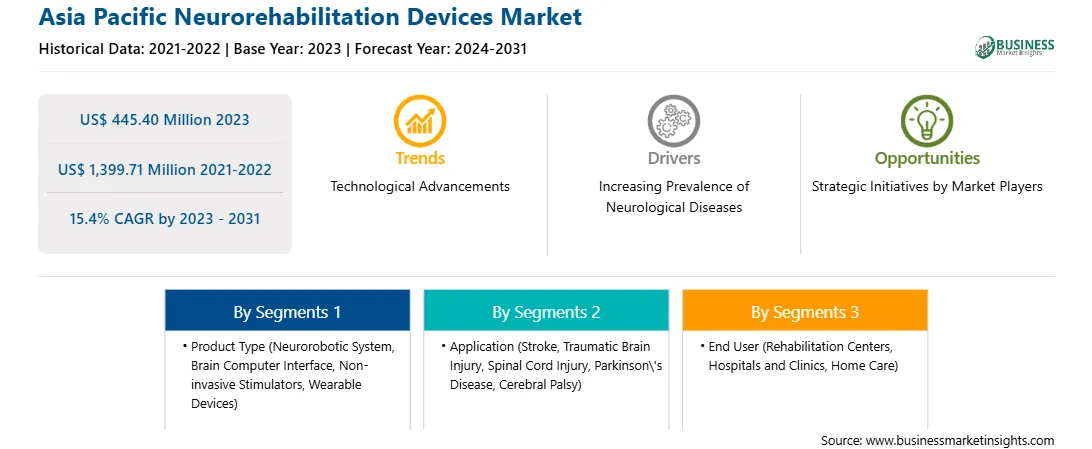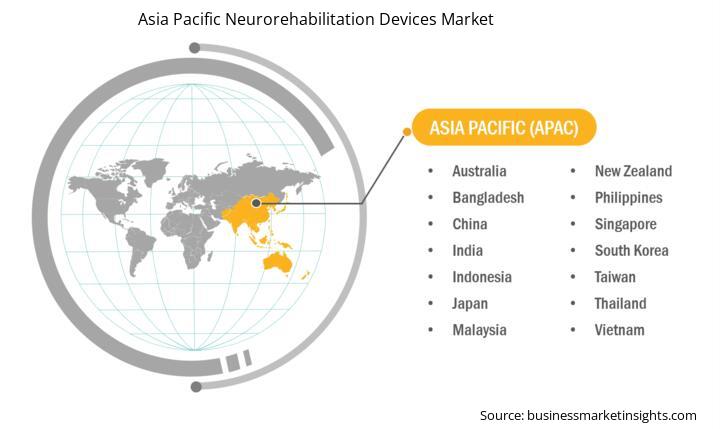The Asia Pacific neurorehabilitation devices market was valued at US$ 445.40 million in 2023 and is expected to reach US$ 1,399.71 million by 2031; it is estimated to register a CAGR of 15.4% from 2023 to 2031.
Strategic Initiatives by Market Players Boost Asia Pacific Neurorehabilitation Devices Market
Strategic initiatives taken by market players, such as mergers, acquisitions, partnerships, and collaborations, are likely to accelerate innovation, develop expertise, and expand market reach.
In April 2022, Blackrock Neurotech partnered with Phantom Neuro, a neurotech startup, to carry out R&D for Phantom Neuro’s patent-pending Phantom X system, which offers patients highly accurate, almost real-time control of current and next-generation assistive devices, such as prosthetics and exoskeletons. This R&D partnership allows Phantom to use Blackrock's decades of experience in neurotechnology and develop biocompatible implantable sensors to complement and bolster the Phantom X platform.
In December 2022, Ekso Bionics—a leader in exoskeleton technology for medical use—announced the acquisition of the Human Motion and Control (“HMC”) Business Unit from Parker Hannifin Corporation. This acquisition will enhance Ekso’s product portfolio and improve its strategic relationships with commercial and research partners such as Vanderbilt University. The partnership with Vanderbilt is expected to enhance its research capabilities and product development.
Thus, the strategic initiatives taken by the market players are likely to create lucrative opportunities for the neurorehabilitation market in the near future.
Asia Pacific Neurorehabilitation Devices Market Overview
The increasing incidences of neurological diseases coupled with the aging population drive the demand for effective rehabilitation solutions. Parkinson's disease (PD) is a common neurodegenerative disease in the country. According to China Daily, there were ~4 million patients suffering from PD in China as of February 2023, and ~1.7% of people over 65 years have been diagnosed with the disease. Neurorehabilitation devices are crucial in managing the symptoms of Parkinson's disease, which is characterized by both motor and non-motor challenges that significantly affect patients' quality of life. These devices help enhance motor function, improve gait and balance, and facilitate daily activities in patients.
Technological developments in robotics and strategic efforts by companies are expected to hold potential growth opportunities for the market in China during the forecast period.
Asia Pacific Neurorehabilitation Devices Market Revenue and Forecast to 2031 (US$ Million)
Strategic insights for the Asia Pacific Neurorehabilitation Devices provides data-driven analysis of the industry landscape, including current trends, key players, and regional nuances. These insights offer actionable recommendations, enabling readers to differentiate themselves from competitors by identifying untapped segments or developing unique value propositions. Leveraging data analytics, these insights help industry players anticipate the market shifts, whether investors, manufacturers, or other stakeholders. A future-oriented perspective is essential, helping stakeholders anticipate market shifts and position themselves for long-term success in this dynamic region. Ultimately, effective strategic insights empower readers to make informed decisions that drive profitability and achieve their business objectives within the market. The geographic scope of the Asia Pacific Neurorehabilitation Devices refers to the specific areas in which a business operates and competes. Understanding local distinctions, such as diverse consumer preferences (e.g., demand for specific plug types or battery backup durations), varying economic conditions, and regulatory environments, is crucial for tailoring strategies to specific markets. Businesses can expand their reach by identifying underserved areas or adapting their offerings to meet local demands. A clear market focus allows for more effective resource allocation, targeted marketing campaigns, and better positioning against local competitors, ultimately driving growth in those targeted areas.
Asia Pacific Neurorehabilitation Devices Strategic Insights

Asia Pacific Neurorehabilitation Devices Report Scope
Report Attribute
Details
Market size in 2023
US$ 445.40 Million
Market Size by 2031
US$ 1,399.71 Million
Global CAGR (2023 - 2031)
15.4%
Historical Data
2021-2022
Forecast period
2024-2031
Segments Covered
By Product Type
By Application
By End User
Regions and Countries Covered
Asia Pacific
Market leaders and key company profiles
Asia Pacific Neurorehabilitation Devices Regional Insights

Asia Pacific Neurorehabilitation Devices Market Segmentation
The Asia Pacific neurorehabilitation devices market is categorized into product type, application, end user, and country.
By product type, the Asia Pacific neurorehabilitation devices market is segmented into neurorobotic system, brain computer interface, non-invasive stimulators, and wearable devices. The brain computer interface segment held the largest share of the Asia Pacific neurorehabilitation devices market share in 2023.
In terms of application, the Asia Pacific neurorehabilitation devices market is segmented into stroke, traumatic brain injury, spinal cord injury, Parkinson's disease, cerebral palsy, and others. The stroke segment held the largest share of the Asia Pacific neurorehabilitation devices market share in 2023.
By end user, the Asia Pacific neurorehabilitation devices market is segmented into rehabilitation centers, hospitals & clinics, and home care. The hospitals & clinics segment held the largest share of the Asia Pacific neurorehabilitation devices market share in 2023.
Based on country, the Asia Pacific neurorehabilitation devices market is segmented into China, Japan, India, Australia, South Korea, and the Rest of Asia Pacific. China segment held the largest share of Asia Pacific neurorehabilitation devices Market in 2023.
Abbott Laboratories; BIONIK; BioXtreme Ltd; Blackrock Microsystems Inc; Ekso Bionics Holdings Inc; EMOTIV; Hocoma AG; Medtronic Plc; Renishaw Plc; and Tyromotion GmbH are some of the leading companies operating in the Asia Pacific neurorehabilitation devices market.
The Asia Pacific Neurorehabilitation Devices Market is valued at US$ 445.40 Million in 2023, it is projected to reach US$ 1,399.71 Million by 2031.
As per our report Asia Pacific Neurorehabilitation Devices Market, the market size is valued at US$ 445.40 Million in 2023, projecting it to reach US$ 1,399.71 Million by 2031. This translates to a CAGR of approximately 15.4% during the forecast period.
The Asia Pacific Neurorehabilitation Devices Market report typically cover these key segments-
The historic period, base year, and forecast period can vary slightly depending on the specific market research report. However, for the Asia Pacific Neurorehabilitation Devices Market report:
The Asia Pacific Neurorehabilitation Devices Market is populated by several key players, each contributing to its growth and innovation. Some of the major players include:
The Asia Pacific Neurorehabilitation Devices Market report is valuable for diverse stakeholders, including:
Essentially, anyone involved in or considering involvement in the Asia Pacific Neurorehabilitation Devices Market value chain can benefit from the information contained in a comprehensive market report.